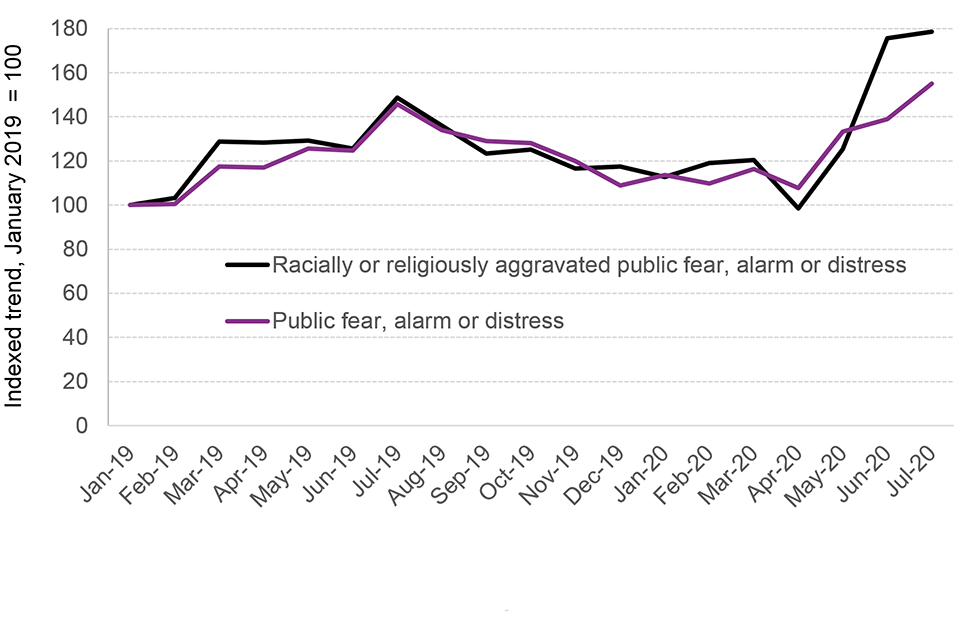Annex to Hate Crime, England and Wales, 2019 to 2020
Updated 28 October 2020
Annex: Provisional trends in racially or religiously aggravated offences to July 2020 under COVID-19 restrictions
This Annex to Hate Crime, England and Wales, 2019 to 2020 provides information on trends in racially or religiously aggravated offences in England and Wales over the period when lockdown restrictions were in place because of the coronavirus (COVID-19) pandemic. Restrictions came into effect from 23 March 2020 and were gradually eased from 13 May 2020, with pubs and restaurants being allowed to re-open from 4 July 2020.
Racially or religiously aggravated offence data are used as they are available for all forces (excluding Greater Manchester Police) on a monthly basis. These data are provisional and subject to change as more information is received from the police.
Figure A1 shows the number of racially or religiously aggravated offences between January and July in both 2019 and 2020. In January and February 2020, the number of offences was higher than the previous year, continuing the upward trend in these offences seen in recent years. This increase was thought to be driven by general crime recording improvements but may also reflect a greater proportion of victims coming forward to report hate crimes to the police and a genuine increase in these offences.
In March, April and May, the level of these offences in 2020 was lower than the previous year. This was particularly marked in April, where the number of offences was down almost a quarter (24%) on the same month in 2019. This pattern was similar to the equivalent non-aggravated offences over the same time period (Figure A2) and reflects the reduction in crime reported by the Office for National Statistics in their Coronavirus and crime in England and Wales: August 2020 statistical bulletin.
Figure A1: Number of racially or religiously aggravated offences recorded by the police, January to July 2019 and 2020

Source: Police recorded crime, Home Office. Figures exclude GMP.
Aggravated offences were higher in 2020 than in 2019 for the months of January, February and, most notably, in June and July. These were lower in 2020 than in 2019 in the months of March, April and May.
In June and July, the pattern was different. The number of racially or religiously aggravated offences in June 2020 was a third higher (34%) than in June 2019. Increases were seen across most forces, with 27 forces seeing an increase of a quarter (25%) or more (data not shown). The level of these offences remained high in July.
Figure A2 shows an extended version of Figure 2 from the main bulletin - indexed trends in racially or religiously aggravated offences and their non-aggravated equivalents. The general trend in both series was similar – with offences gradually increasing over the time period shown. However, the aggravated offences trend showed a greater fluctuation and apparent seasonality than the non-aggravated equivalent offences. Spikes can be seen in racially or religiously aggravated offences which were not evident in the non-aggravated equivalents in July 2016 (following the EU Referendum result), July 2017 (following the terrorist attacks) and June and July 2020.
Figure A2: Indexed trends in the number of racially or religiously aggravated offences and their non-aggravated equivalents1 recorded by the police, April 2015 to July 2020

Source: Police recorded crime, Home Office. Figures exclude GMP.
See Table 1.1 for list of offences covered.
The trend in both series was similar – offences gradually increasing. However, the aggravated offences showed a greater fluctuation and seasonality than the non-aggravated equivalents. Spikes can be seen in racially or religiously aggravated offences which were not evident in the non-aggravated equivalents in July 2016, July 2017 and June and July 2020 (208).
The increases seen in June and July 2020 were likely to be related to the Black Lives Matters protests and far-right groups counter-protests in England and Wales following the death of George Floyd on the 25 May in the United States of America.Figure A3 shows there were increases in both racially or religiously aggravated and non-aggravated public fear, alarm or distress offences in May, June and July 2020. Increases in these offences are common when there are an increased number of protests. There may also be other factors behind the increase in these offences.
As public fear, alarm or distress offences account for around three-quarters of racially[footnote 1] or religiously aggravated offences, they tend to drive trends in these aggravated offences, hence the rise in seen in June and July in Figure A2.
Figure A3: Indexed trends in the number of public fear, alarm or distress offences (aggravated and non- aggravated) recorded by the police, January 2019 to July 2020

Source: Police recorded crime, Home Office. Figures exclude GMP.
Indexed aggravated public fear, alarm or distress offences follows a similar trend to indexed non aggravated equivalents, with spikes in July 2019, June 2020 and July 2020.
-
72% of racially of religiously aggravated offences were for public fear, alarm or distress in 2019 to 2020. ↩
